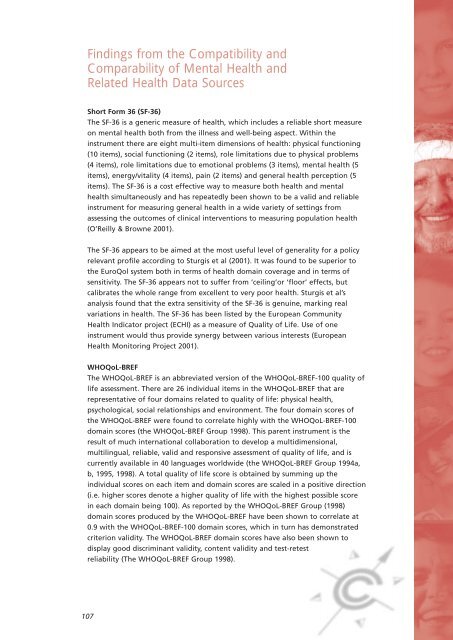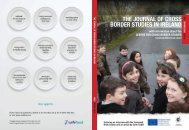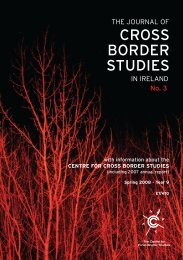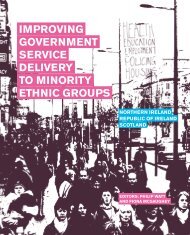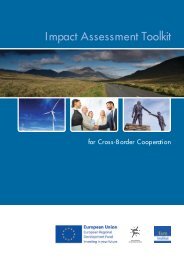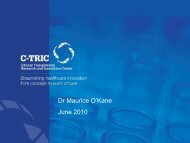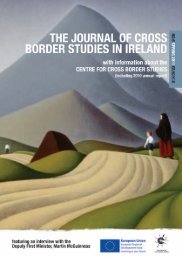4858 Mental Health Report - National University of Ireland, Galway
4858 Mental Health Report - National University of Ireland, Galway
4858 Mental Health Report - National University of Ireland, Galway
Create successful ePaper yourself
Turn your PDF publications into a flip-book with our unique Google optimized e-Paper software.
Findings from the Compatibility and<br />
Comparability <strong>of</strong> <strong>Mental</strong> <strong>Health</strong> and<br />
Related <strong>Health</strong> Data Sources<br />
Short Form 36 (SF-36)<br />
The SF-36 is a generic measure <strong>of</strong> health, which includes a reliable short measure<br />
on mental health both from the illness and well-being aspect. Within the<br />
instrument there are eight multi-item dimensions <strong>of</strong> health: physical functioning<br />
(10 items), social functioning (2 items), role limitations due to physical problems<br />
(4 items), role limitations due to emotional problems (3 items), mental health (5<br />
items), energy/vitality (4 items), pain (2 items) and general health perception (5<br />
items). The SF-36 is a cost effective way to measure both health and mental<br />
health simultaneously and has repeatedly been shown to be a valid and reliable<br />
instrument for measuring general health in a wide variety <strong>of</strong> settings from<br />
assessing the outcomes <strong>of</strong> clinical interventions to measuring population health<br />
(O’Reilly & Browne 2001).<br />
The SF-36 appears to be aimed at the most useful level <strong>of</strong> generality for a policy<br />
relevant pr<strong>of</strong>ile according to Sturgis et al (2001). It was found to be superior to<br />
the EuroQol system both in terms <strong>of</strong> health domain coverage and in terms <strong>of</strong><br />
sensitivity. The SF-36 appears not to suffer from ‘ceiling’or ‘floor’ effects, but<br />
calibrates the whole range from excellent to very poor health. Sturgis et al’s<br />
analysis found that the extra sensitivity <strong>of</strong> the SF-36 is genuine, marking real<br />
variations in health. The SF-36 has been listed by the European Community<br />
<strong>Health</strong> Indicator project (ECHI) as a measure <strong>of</strong> Quality <strong>of</strong> Life. Use <strong>of</strong> one<br />
instrument would thus provide synergy between various interests (European<br />
<strong>Health</strong> Monitoring Project 2001).<br />
WHOQoL-BREF<br />
The WHOQoL-BREF is an abbreviated version <strong>of</strong> the WHOQoL-BREF-100 quality <strong>of</strong><br />
life assessment. There are 26 individual items in the WHOQoL-BREF that are<br />
representative <strong>of</strong> four domains related to quality <strong>of</strong> life: physical health,<br />
psychological, social relationships and environment. The four domain scores <strong>of</strong><br />
the WHOQoL-BREF were found to correlate highly with the WHOQoL-BREF-100<br />
domain scores (the WHOQoL-BREF Group 1998). This parent instrument is the<br />
result <strong>of</strong> much international collaboration to develop a multidimensional,<br />
multilingual, reliable, valid and responsive assessment <strong>of</strong> quality <strong>of</strong> life, and is<br />
currently available in 40 languages worldwide (the WHOQoL-BREF Group 1994a,<br />
b, 1995, 1998). A total quality <strong>of</strong> life score is obtained by summing up the<br />
individual scores on each item and domain scores are scaled in a positive direction<br />
(i.e. higher scores denote a higher quality <strong>of</strong> life with the highest possible score<br />
in each domain being 100). As reported by the WHOQoL-BREF Group (1998)<br />
domain scores produced by the WHOQoL-BREF have been shown to correlate at<br />
0.9 with the WHOQoL-BREF-100 domain scores, which in turn has demonstrated<br />
criterion validity. The WHOQoL-BREF domain scores have also been shown to<br />
display good discriminant validity, content validity and test-retest<br />
reliability (The WHOQoL-BREF Group 1998).<br />
107


